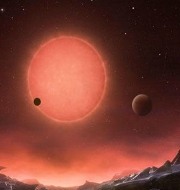Jupiter-like planet Kepler1647b orbiting two suns discovered
Scientists using NASA’s Kepler Space Telescope have discovered a Jupiter-like circumbinary planet named Kepler1647b orbiting a system of two stars.
The planet was discovered by astronomers from NASA’s Goddard Space Flight Centre and San Diego State University (SDSU).
Kepler1647b is the largest such cosmic body ever found. Circumbinary planets are those planets that orbit two stars.
Key Facts
- Kepler1647b is located in the constellation Cygnus. It is 3,700 light-years away.
- It is about 4.4 billion years old i.e. roughly the same age as the Earth.
- Kepler1647b’s mass and radius nearly identical to that of Jupiter. This makes it the largest transiting circumbinary planet ever found.
- The planet takes 1,107 days (over 3 years) to orbit its host stars. This is the longest period of any confirmed transiting exoplanet found so far.
- Kepler-1647b is a gas giant which makes it unlikely to host life. The stars of the planet are similar to our Sun, with one slightly larger than our home star and the other slightly smaller.
About Kepler Space Telescope (KST)
- KST is an unmanned space observatory launched in 2009 by NASA (National Aeronautics and Space Administration).
- It is tasked with determining how commonly, Earth-like planets occur throughout the Milky Way galaxy.
- It has been designed for a statistical mission and not to probe into the environmental conditions of planets that exist in the so-called Goldilocks zone of their stars.
- KST works by observing a dimming in the light of a star, known as a transit, each time an orbiting planet passes in front of it.
Month: Current Affairs - June, 2016


